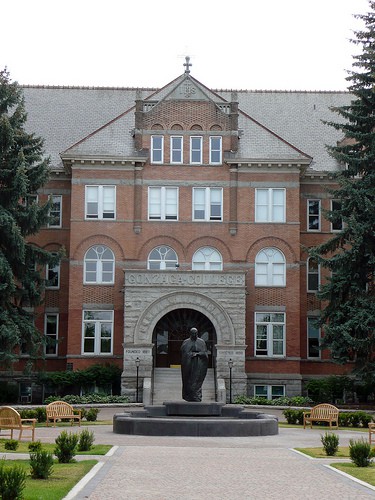
This is the second day that I’m devoting to evaluating financial aid letters.
If you missed it, here is the first post that I wrote on this important subject: What’s Wrong with This Financial Aid Letter?
Today I’m sharing another financial aid award that I obtained from Paula Bishop, a CPA from Bellevue, WA, who received this letter from a client.
This financial aid award comes from Gonzaga University. Bishop added everything that you see in the two red boxes. Take a look:
How Good is This Award?
It’s award letters like this that helps explain why I am such a higher-ed cynic.
This is a poor financial aid award and yet at the top of the award letter Gonzaga brags that the award provides a total commitment of $62,360 over four years. I assume the school is trotting out a four-year figure because it will appear more generous than the terrible one-year award this student actually received.
The four-year award wouldn’t look so good if the letter also noted that the four-year cost of the school will easily exceed $188,000.
A Close Look at the Gonzaga Award
The student who received this award is an excellent student (3.9 GPA) and is also poor. In fact, the student’s Expected Family Contribution is $0. A family’s adjusted gross income is automatically $0 if their adjusted gross income is $23,000 or less.
(This post explains what you need to know about Expected Family Contributions.)
The cost of attendance at Gonzaga is $47,000. With an EFC of $0, this family’s demonstrated need is $47,000.
Gonzaga is giving this child grants/scholarships worth $15,590 for the child’s freshman year. The school also inserted into the package the full federal Pell Grant for low-income students that’s worth $5,550 and a work study job (the screen shot doesn’t show the work-study job).
When you add up the three grants and the subsidized Stafford Loan (Gonzaga referred to it as Direct Sub. Loan), it pencils out to just $24,640. (It’s okay for colleges to include a subsidized Stafford in a package because it is geared toward low-income students and has special features compared to the regular Stafford Loan.)
When you add up the institutional and federal grants, subsidized Stafford Loan and work study, Gonzaga only meets 52% of this family’s financial need.
What’s Missing
Here is what the Gonzaga letter didn’t mention:
Expected Family Contribution.
Since the letter doesn’t include what the family’s EFC is, the parents would have no idea whether the award is a good one or not.
Cost of Attendance.
This is another glaring omission. If you don’t know what the total cost of the school is, how is any family expected to know what their total outlay would be?
Bottom Line:
This is a textbook example of a student being gapped. In this case, there is a huge gap between the financial assistance that the child neeeds to attend Gonzaga and what the school is willing to provide. I’d suggest it would be financial suicide for this low-income student to attend this school.
An Excellent Financial Aid Award
Now that you’ve seen two poor financial aid awards, in my next post I’m going to show you what an excellent financial aid award looks like.



Oh, and I realize this post was from a while back, but my niece is now a junior at Gonzaga, so was fielding financial aid letters around the same time as this one.
I found this award fascinating and disappointing. My affluent niece attends Gonzaga where she was awarded a massive merit scholarship as a 4.0 student, and her parents are reputedly paying just $25,000 a year. Their EFC is much higher than that. I find the disconnect between her experience and this award letter to be disturbing and arbitrary. My daughter is a senior with top grades and we are awaiting financial aid letters. I’m worried.
On a lighter note, I know a lower-income family with a tiny EFC whose science scholar son is attending Evergreen State College, and his fees are paid in full. Don’t know the details on the variety of scholarships he was awarded, but suffice to say this family is paying $0. That school is worth looking into for top students if it’s the right fit.
Hi Lynn am Rahul, 25 years, Indian. Am completing my MBA from Cyprus in June 2013. There after I wish to study as well as work, if possible, in USA. I have been searching a suitable college through internet for months together. But the more I search, the more I’m getting confused. Can u please help me in finding a good college with maximum possible financial aid. Thanx in advance..
[email protected]
It’s so important to carefully evaluate financial awards and hey, I’m glad you’re a cynic – your perspective helps the rest of us who might be impressed by what’s in fact not such a great award.
“I’m sharing another financial aid award that I obtained from Paula Bishop, a CPA from Bellevue, WA, who received this letter from a client.”
A “poor” family with an EFC of $0 has a CPA?
Jay — It is a pro bono case.
Lynn O.
Awards like this are absurd. The acceptance to the school amounts to nothing more than a consolation prize because there is no way that the student can attend. This aid package translates to the family undertaking debt PER YEAR that is equal to its AGI. Who in their right mind is going to do that?
This is a perfect example of the huge obstacles facing students from low income families. Unless they get into a college that meets full need without loans, they probably aren’t going to college (or if they do, they probably won’t graduate – yet will have accumulated debt). To get into a college that meets full need is a Herculean task for anyone; even more so for low income kids. Because money is tight, these kids often don’t have access to test prep and often don’t have an impressive list of extracurriculars (which can be expensive and / or require transportation). I’m sure they think, “Why bother?”
Wow, this is a terrible offer. Gonzaga claims to meet an average of 83% of need on their website and this student is only getting 52% of need met. It sure doesn’t look like the school was very interested in having this student attend! I hope he/she applied to other schools that were more interested in meeting his/her need. Wouldn’t you normally expect a fully subsidized Stafford loan ($5500) for a student with a $0 EFC?
Wendy – I seriously question whether the self-reported published figures on percentage of need met that are shared by schools on their Common Data Sets are accurate. I believe a lot of them aren’t.
Lynn O’Shaughnessy